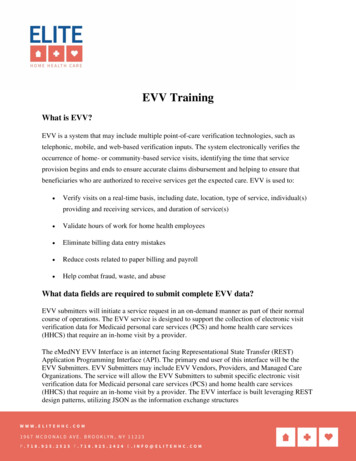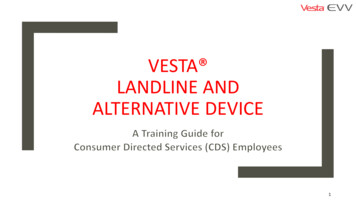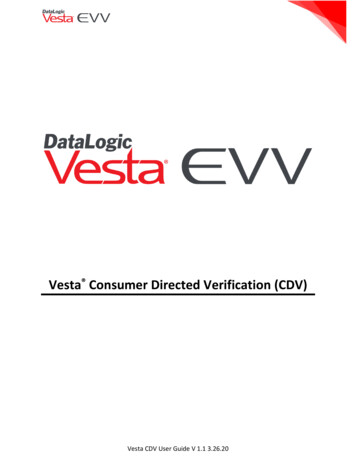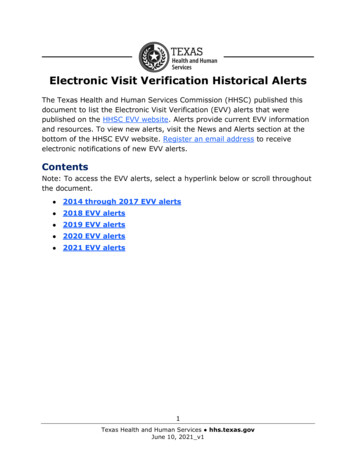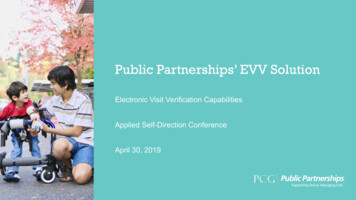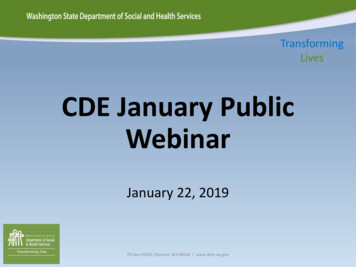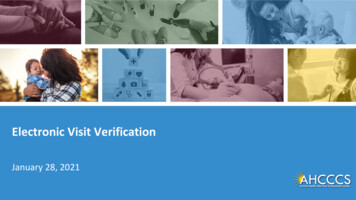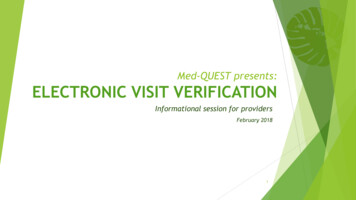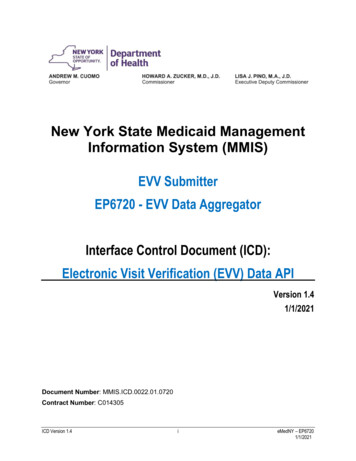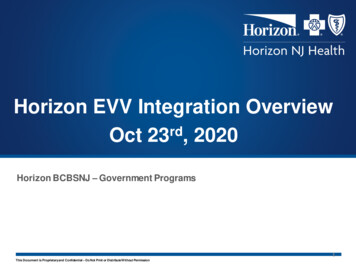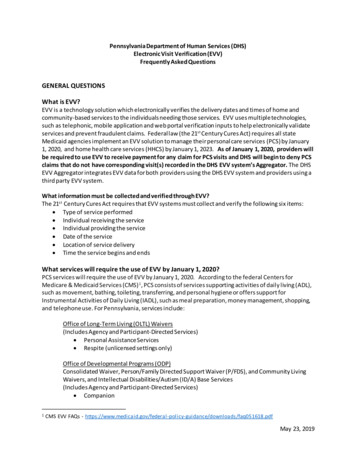
Transcription
Pennsylvania Department of Human Services (DHS)Electronic Visit Verification (EVV)Frequently Asked QuestionsGENERAL QUESTIONSWhat is EVV?EVV is a technology solution which electronically verifies the delivery dates and times of home andcommunity-based services to the individuals needing those services. EVV uses multiple technologies,such as telephonic, mobile application and web portal verification inputs to help electronically validateservices and prevent fraudulent claims. Federal law (the 21st Century Cures Act) requires all stateMedicaid agencies implement an EVV solution to manage their personal care services (PCS) by January1, 2020, and home health care services (HHCS) by January 1, 2023. As of January 1, 2020, providers willbe required to use EVV to receive payment for any claim for PCS visits and DHS will begin to deny PCSclaims that do not have corresponding visit(s) recorded in the DHS EVV system’s Aggregator. The DHSEVV Aggregator integrates EVV data for both providers using the DHS EVV system and providers using athird party EVV system.What information must be collected and verified through EVV?The 21st Century Cures Act requires that EVV systems must collect and verify the following six items: Type of service performed Individual receiving the service Individual providing the service Date of the service Location of service delivery Time the service begins and endsWhat services will require the use of EVV by January 1, 2020?PCS services will require the use of EVV by January 1, 2020. According to the federal Centers forMedicare & Medicaid Services (CMS) 1, PCS consists of services supporting activities of daily living (ADL),such as movement, bathing, toileting, transferring, and personal hygiene or offers support forInstrumental Activities of Daily Living (IADL), such as meal preparation, money management, shopping,and telephone use. For Pennsylvania, services include:Office of Long-Term Living (OLTL) Waivers(Includes Agency and Participant-Directed Services) Personal Assistance Services Respite (unlicensed settings only)Office of Developmental Programs (ODP)Consolidated Waiver, Person/Family Directed Support Waiver (P/FDS), and Community LivingWaivers, and Intellectual Disabilities/Autism (ID/A) Base Services(Includes Agency and Participant-Directed Services) Companion1CMS EVV FAQs - https://www.medicaid.gov/federal -policy-guidance/downloads/faq051618.pdfMay 23, 2019
In-Home and Community SupportRespite (unlicensed settings only and camp)HomemakerAdult Autism Waiver Community Support Respite (unlicensed settings only)What are the benefits of an EVV system?EVV can help improve quality of care by making caregiver activities transparent and measurable. Also,EVV reduces the likelihood for error or fraud by identifying the participant, recording the individualcaregiver’s location and clock-in and clock-out time, and services provided.What is PA DHS doing to implement an EVV system?DHS intends to implement the EVV requirements so that the system is minimally burdensome and isresponsive to input from stakeholders. DHS is currently working with its EVV vendors (DXC and Sandata)to develop an EVV system that will integrate with DHS’s existing Medicaid Management InformationSystem (MMIS), PROMISe . DHS plans to have the state’s EVV system “go-live” in September 2019followed by a soft launch date of EVV of October 2019 (see below for definition“soft launch”). DHS willprovide regular updates on the progress of the implementation and will contact provider agencies withsurveys, informational updates, and stakeholder briefings throughout the implementation process.Pennsylvania will be implementing an open EVV system model. DHS is developing and will offer the DHSEVV system to providers. Providers may choose to use their own EVV vendor/system so long as theirsystem captures the six items required under the Cures Act and can interface with the DHS Aggregator,which is defined below. Technical specifications for these “Alternate” EVV systems to interface with theDHS Aggregator will be made available once they are finalized.When will the DHS EVV system be available to providers?In September 2019, the DHS EVV system will be available and provider training for the DHS EVV systemwill begin. Once providers have completed training, providers will obtain their log-in credentials toaccess the DHS EVV system. Providers must complete training before they gain access and begin usingthe system to capture EVV data. During September 2019, providers should create accounts and trainstaff prior to the soft launch period which begins in October 2019. This time will allow for providers tofamiliarize themselves with the platform prior to expected use of the DHS EVV system beginning inOctober 2019.What does soft launch mean?DHS plans a “soft launch” period between October and December 2019, prior to the required PCSimplementation date of January 1, 2020. During the soft launch period, DHS will expect provideragencies to utilize the DHS EVV system or their Alternate EVV system that will interface with the DHSAggregator. The soft launch period between October and December 2019 will be a time for providersand clients to adapt to the use of EVV without impact to claims. During this soft launch, DHS andSandata will be available to answer questions and concerns that may come up regarding EVV.Additionally, DHS will analyze usage data to determine which providers are not utilizing EVV adequatelyand will reach out to provide direct technical assistance. During this time, DHS will also generate reportswhich indicate the percent of required claims that fail to meet EVV requirements.May 23, 2019
What is the DHS Aggregator?The DHS Aggregator is a system that will integrate data from third-party systems (also referred to asAlternate EVV) and the DHS EVV system into a single uniform platform to facilitate payments of claims.The DHS Aggregator allows providers to continue to use a third-party system (also referred to asAlternate EVV) for visit verification. The six CMS data requirements are transmitted from the AlternateEVV system to the DHS Aggregator using Sandata’s standard data specification. The DHS Aggregatorincludes a read-only web portal for the provider to view their data and a payer web portal whichincludes alerts, real-time data views, and reporting.What is the expected timetable for deployment, education, and training on the DHS EVVsystem?Classroom and webinar training for the DHS EVV system will begin in September 2019 and continuethrough the Fall of 2019. Self-paced, online training will also be made available during this time and willbe available after full implementation of the DHS EVV system in January 2020. Information related tothe training dates and times will be provided ahead of time and will be posted to the DHS EVV website.Additional information related to training may be found in the “Training” section below.How can I ensure that I receive all the information I need about Pennsylvania’s EVV program?The DHS EVV website will continue to be updated with additional information s may also sign-up for the DHS EVV Listserv by sending a request to RA-PWEVVNotice@pa.govWho do I contact if I have a question about EVV?Questions about the overall EVV program should be sent to RA-PWEVVNotice@pa.gov If a call ispreferred, EVV program questions may be directed to 717-787-2600.PROVIDER QUESTIONSIs there a cost for using the DHS EVV system?DHS will not charge providers for the use of the DHS EVV system scheduled to go live in September2019. However, agency providers who choose to use an Alternate EVV system may be charged for thatsystem. Such providers will be responsible for working with DHS and its vendor, Sandata, to integratewith the DHS Aggregator and will be responsible for any interface costs charged by the provider’sAlternate EVV vendors.What are the different ways that visits can be captured through the DHS EVV system?The DHS EVV system allows for visits to be captured through the mobile application and throughtelephony visit verification. Corrections to EVV data can be made by providers through the web portal.Do I have to buy smartphones for my caregivers?A smartphone is not required for the DHS EVV system. The DHS EVV system allows for the use of eitherthe mobile application or telephony visit verification to record the required visit information. Both themobile application and telephony visit verification allow for verifying caregiver visit date, time andMay 23, 2019
location. A smart device is only necessary if the caregiver uses the mobile application to capture the visitdata; however, the use of the mobile application is optional and DHS does not prefer the use of themobile application over telephony. For caregivers using the mobile application as part of the DHS EVVsystem, DHS has a bring your own device (BYOD) policy where employees may use their personalcomputing devices, such as smartphones and tablets, to download and access the mobile application.The mobile application called “Sandata Mobile Connect” is a free application that is available on IOS andAndroid operating systems.Will there be help with the cost for people who don’t currently have data plans?DHS will not cover the costs associated with data plans.Do I have to use the DHS EVV system?No. While the DHS EVV system will be offered to providers, Pennsylvania is using an open EVV systemmodel and providers may use their own EVV vendor/system so long as it captures the six required itemsand can interface with the DHS Aggregator. Technical specifications for alternative EVV systems tointerface with the DHS Aggregator will be made available once they are finalized.What do you consider the “location” and how will this information be collected in the DHSEVV system?For the mobile application, GPS latitude and longitude will be captured when the visit begins at check-in(the beginning of the provision of the service) and when the visit ends at check-out (the conclusion ofthe service). Location service must be enabled. GPS coordinates will be captured regardless of whetherthe mobile device is connected to a network. Locations visited by the caregiver and the individualreceiving support in-between check-in and check-out will not be captured.For telephony visit verification, the location will be based on the phone number associated with theclient’s address or the address associated with the phone number from which the call is made.What happens if the caregiver’s EVV device cannot connect to the system when using theDHS EVV mobile application?Telephony can be used to capture visit information if cellular coverage is not a viable option for aspecific visit. The mobile application is also able to collect visit information in an offline mode andupload the visit information to the system when connectivi ty is available.Some participants do not have a home phone. Will a home phone be required for EVV?EVV does not require participants to have a landline home phone. Caregivers can capture their visitinformation using the app on their smartphone, or by calling the telephone number associated with thetelephony visit verification system on their cell phone or smartphone.Does every employee need to have an email address to use the DHS EVV mobileapplication? What if they do not have a work email or a personal email?Yes. Every employee who has access to the DHS EVV mobile application will need a unique emailaddress. The employee will be required to create a new email address if they do not have an individualemail address to log-in to the EVV application. The caregiver’s email address will be utilized to identifythe caregiver delivering care to the participant. The email address is used as the caregiver’s username toaccess the application and to respond to password reset requests.May 23, 2019
What happens if the caregiver needs to run errands for a participant prior to arriving athis/her home to provide authorized services?EVV does not affect access to care or provision of services. If the caregiver service allows errands andthe services are on the plan, EVV permits the caregiver to complete errands for the participant prior toarriving at his/her home.Can more than one provider use the same device to record services to an individual?Yes. Every caregiver will have unique login credentials.How will an individual receiving services verify times and service?An individual receiving services will have the ability to verify times and service by voice recording or adigital signature either through the mobile application or through telephony.Will patient signatures be required at the end of every visit if the agency is using EVV?If a service requires a signature prior to the implementation of EVV, then the service will still require asignature or voice capture to verify the services received once EVV is implemented. For example,consumer-directed services require a signature to verify the services. A signature will be required forthese service visits once EVV is implemented.Will we be able to round units?If you are currently able to round units, then you will still be able to do so with the DHS EVV system.What happens if check-in and/or check-out times cannot be, or are not, captured?Check-in and check-out times are required information that must be captured as part of the visit. Ininstances where the check-in and check-out times are unable to be captured through the mobileapplication or telephony, the times can be fixed through manual entry in the web portal.Will different modalities for check-in and check-out be allowable in the DHS EVV system?Yes, a caregiver can check-in using the mobile application and check-out using telephony (or vice versa).What happens if the times on my claim don’t match the times recorded in the DHS EVVsystem?An exception will be generated in the EVV system.What if there is a schedule change?Clock-in and clock-out should capture any schedule changes. Where exceptions occur, the provideragency will have the ability to make edits, error corrections and changes through manual entry in theweb portal.Will there be a drop-down list of services in the mobile application of the DHS EVV system?Yes, there will be a drop-down list of service options that can be selected. For those providers opting touse the scheduling module within the DHS EVV system, the scheduled visit information will be prepopulated and will not require the selection of services by the caregiver when entering visit information.If an unscheduled service is delivered at the point of care, the caregiver will need to select a service fromMay 23, 2019
the drop-down list.How will EVV impact billing?The 21st Century Cures Act requires electronic verification of visits for Medicaid-funded care before theycan be paid by DHS. Beyond verification, there should not be any impact on billing.Will I need additional staff to manage EVV?No, additional staff should not be needed to manage EVV. It is very important to make sure thatboth caregiver staff and office staff are fully trained and compliant with EVV. This will helpensure a smooth and successful EVV implementation for your agency.What languages will be provided as part of the DHS EVV system?The telephone system used by the EVV system has English and Spanish call prompts.Additionally, the EVV caregiver training materials and help reference guides are also provided inEnglish. Telephony visit verification and the mobile application will be made available in Englishand the following languages: Egyptian ArabicFrenchFulaniHindiMandarin SwahiliVietnameseTECHNOLOGY QUESTIONSWill the DHS EVV mobile application track my movements?No. The mobile application only captures the GPS location when the service begins (at check-in) andends (at check-out).How secure is the data that is transmitted through the DHS EVV system?Regarding data breach concerns, DHS has taken every precaution to ensure our systems are resilient andmeet the Commonwealth’s IT policies. The Sandata platform is Health Insurance Portability andAccountability Act (HIPAA) compliant and is Health Information Trust Alliance (HITRUST) certified.What measures assure provider data protection?May 23, 2019
EVV system access is protected by a unique user ID and password. Providers should maintain theconfidentiality of that information. The DHS EVV vendor, Sandata, uses encryption and other securityprotocols on their servers. Sandata installs and maintains up-to-date firewalls and virus protection,conducts a periodic review of users and access rights, reviews and applies security patches and reviewsand analyzes system activity logs. Additionally, when communicating via email to the agencies, SandataCustomer Care will use encryption when responding if the email contains confidential information.How long is it between when visit information is entered and when I can see it in the DHSEVV portal?Visit information is generally available in the DHS EVV Portal in near real time. Data is typically uploadedand available within a few minutes.If I am already using an EVV technology, do I have to switch to the DHS EVV system?You may continue to use your current EVV system but you must meet DHS EVV business requirementsand Sandata technical specifications. Both the business requirements and the technical specificationswill be made available on the DHS EVV website. Providers will be responsible for working with Sandataand for any interface costs charged by their vendors if they choose to use their own system.If I have my own EVV technology, how do I interface with the DHS EVV system?EVV Business Requirements for Alternate EVV Data Collection Components will be made available on theDHS EVV website. You may also email the resource account to request to receive a copy: RAPWEVVNotice@pa.gov .What if my Alternate EVV System vendor cannot map its values to DHS EVV system fieldvalues?The data in the DHS Aggregator must be consistent across the program. Therefore, Alternate EVVSystems must send the same values in the format and manner specifie d in the technical specification.You will need to use the DHS EVV system if your vendor cannot accommodate the values, format, orinterface requirements defined in the Alternate EVV System Technical Specifications. DHS will releasethe technical specifications in May 2019.If my alternate vendor already went through the Sandata Alternate EVV certification process,do I need to complete the certification process also?Yes. Even though a different agency has an approved interface from your Alternate EVV vendor to theDHS Aggregator, you must complete the testing process to ensure the interface works with yourAlternate EVV System and to gain Sandata’s approval.When must I complete my interface to the DHS Aggregator?DHS EVV implementation is planned for October 7, 2019. If you choose to use an Alternate EVV systemat the start of the program, we recommend that you complete the certification process at least 60 daysprior to the soft launch date of October 7, 2019.How will the DHS EVV system work with PROMISe ?The DHS EVV system will receive ongoing participant and authorization data from the EVV portal andclaims may be submitted directly into the PROMISe portal. You will continue to use the PROMISe portal to see if your claims were accepted.May 23, 2019
How do I know if my claims were accepted or rejected?You will continue to use the same process you use today to see if your claims were accepted or rejected.There should be few rejected claims since the DHS EVV system makes sure you have all the requiredclaims data prior to submission. You will also receive training on how you can resubmit claims throughthe DHS EVV system if necessary.Can schedules created in advance be edited in the DHS EVV system?Yes. There are multiple ways to edit schedules which will be covered in training.Is there a way to export submitted claim data into QuickBooks or other external payroll oraccounting applications?The DHS EVV system provides a standard extract of information function to permit delivery to thirdparty accounting and payroll systems. Reports from the DHS EVV system can be exported in PDF, Excel,and .csv formats. The ability to integrate specifically with QuickBooks format will be dependent on yoursystem requirements.What sort of EVV reports will DHS be looking at?A variety of reports will be available to both the providers and DHS. DHS will determine which reports itwill use to monitor and manage both EVV and home and community-based services. Providers will haveaccess to the same data and will be trained on reporting as part of the deployment.Does the DHS EVV system integrate with an electronic health record (EHR) system?Yes. DHS EVV will integrate with other systems.Why must caregivers provide their Social Security Number (SSN)? What is it used for?For those caregivers without a DHS assigned unique registry identification, the DHS EVV system willrequire the last five (5) digits of the caregiver’s SSN for system identification purposes. The DHS EVVprogram provides DHS the ability to view reports and drill down into details of each EVV contact. Thelast five digits of the SSN allows for cross-agency reporting and analysis to maintain an effectiveprogram. The system is secured to only allow authorized DHS representatives to view the caregiverinformation entered into the DHS EVV system. Caregivers may sign up for a DHS assigned unique registryID through this website: https://www.humanservices.state.pa.us/dcwWhat happens if the DHS EVV mobile application cannot connect to the system?If GPS or cellular coverage is not a viable option for a specific visit, you can use telephony visitverification to capture visit information.Are the phone numbers used to call-in visit verification toll-free?Yes, and access is available 24 hours a day, seven days a week. DHS EVV telephony visit verification tollfree numbers will be provided at a later date.What browsers does the DHS EVV system support?The DHS EVV system supports the following browsers: Microsoft Internet Explorer v9 or higher, MozillaFirefox v44.0 or higher, or Google Chrome. Other browsers have not been certified to provide fullfunctionality of the EVV system and are not recommended.Who is responsible for installing the DHS EVV system web portal?May 23, 2019
There is nothing to install. Your agency, including all users, will access the DHS EVV system via theweb. This requires a current web browser and sufficient internet connection.Will DHS help agencies upload data into the DHS EVV system?DHS will offer a spreadsheet option for agencies serving 80 or more individuals. Those agencies will beable to populate the spreadsheet with their caregivers and individuals receiving services. When theagency returns the completed spreadsheet, Sandata will permit a one-time courtesy upload of the datainto the DHS EVV system. After the initial upload, the agency will be responsible for maintaining EVVdata.Where should edits be made, if needed, when using an Alternate EVV system?All edits to visits made through an Alternate EVV system can only be made directly through theAlternate EVV system.TrainingWhat kind of training will be available for providers?Before the soft launch of the DHS EVV system in October 2019, training will be offered for providers.Providers can choose a classroom setting, an instructor-led webinar training, or self-paced on-linetraining.1. Face to face classroom training in sites across the Commonwealth.2. Instructor-led webinars available via Zoom video webinar.3. Self-paced training available through Sandata’s Learning Management System.The training schedule and additional training information will be made available on the DHS EVV websiteat: electronicvisitverification/index.htmDo I have to go to training to use the DHS EVV system?If opting to use the DHS EVV system, all agency providers of services subject to EVV must attend trainingprior to receiving login credentials for the DHS EVV system. It is recommended that each provideragency have two staff members attend a classroom session or live webinar. Agency provider trainingattendees will be responsible for training their agency’s caregiver staff.How many employees can I send to training?Each provider agency can send a total of two representative to any combination of classroom andwebinar training.Is DHS covering the cost of training office and caregiver staff?Training is offered free of charge to all Medicaid Providers affected by EVV deployment. Providers mayonly bill for services rendered. Administrative costs such as training are built into the service rates andtherefore are not considered billable.Each agency is responsible for training their staff. DHS will provide educational aids and referencematerials on the DHS EVV website at when training mation/electronicvisitverification/index.htmMay 23, 2019
to develop an EVV system that will integrate with DHS's existing Medicaid Management Information System (MMIS), PROMISe . DHS plans to have the state's EVV system "go-live" in September 2019 . GPS latitude and longitude will be captured when the visit begins at check-in (the beginning of the provision of the service) and when the .
